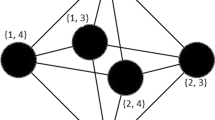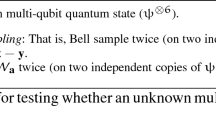Abstract
In 1964 Shapley observed that a matrix has a saddle point in pure strategies whenever every its \(2 \times 2\) submatrix has one. In contrast, a bimatrix game may have no pure strategy Nash equilibrium (NE) even when every \(2 \times 2\) subgame has one. Nevertheless, Shapley’s claim can be extended to bimatrix games as follows. We partition all \(2 \times 2\) bimatrix games into fifteen classes \(C = \{c_1, \ldots , c_{15}\}\) depending only on the preferences of two players. A subset \(t \subseteq C\) is called a NE-theorem if a bimatrix game has a NE whenever it contains no subgame from t. We suggest a method to construct all minimal (that is, strongest) NE-theorems based on the procedure of joint generation of transversal hypergraphs given by a special oracle. By this method we obtain all (six) strongest NE-theorems. Let us remark that the suggested approach, which may be called “math-pattern recognition”, is very general: it allows to characterize completely an arbitrary “target” in terms of arbitrary “attributes”.







Similar content being viewed by others
References
Berger U (2007) Two more classes of games with the continuous-time fictitious play property. Games Econ Behav 60(2):247–261
Boros E, Gurvich V, Makino K (2009) Minimal and locally minimal games and game forms. Discrete Math 309(13):4456–4468
Boros E, Gurvich V, Makino K, Papp D (2010) Acyclic, or totally tight, two-person game forms, characterization and main properties. Discrete Math 310(6–7):1135–1151
Chvatal V, Lenhart WJ, Sbihi N (1990) Two-colourings that decompose perfect graphs. J Combin Theory Ser B 49:1–9
Edmonds J, Fulkerson DR (1970) Bottleneck Extrema, RM-5375-PR. The Rand Corporation, Santa Monica, Ca., Jan. 1968. J Combin Theory 8:299–306
Echenique F (2004) A characterization of strategic complementarities. Games Econ Behav 46(2):325–347
Fredman M, Khachiyan L (1996) On the complexity of dualization of monotone disjunctive normal forms. J Algorithms 21(3):618–628
Gurvich V (1973) To theory of multi-step games. USSR Comput Math Math Phys 13(6):143–161
Gurvich V (1975) Solution of positional games in pure strategies. USSR Comput Math Math Phys 15(2):74–87
Gurvich V (1988) Equilibrium in pure strategies. Sov Math Doklady 38(3):597–602
Gurvich V, Khachiyan L (1999) On generating the irredundant conjunctive and disjunctive normal forms of monotone Boolean functions. Discrete Appl Math 96–97:363–373
Gurvich V, Libkin L (1990) Absolutely determined matrices. Math Soc Sci 20:1–18
Gvishiani AD, Gurvich VA (1983) Dual set systems and their applications, Izvestiya Akad. Nauk SSSR, ser. Tekhnicheskaya Kibernetika 4:31–39 (in Russian) [English translation in Sov J Comput Syst Sci (formerly Engineering Cybernetics)]
Hofbauer J (1995) Stability for the best response dynamics, mimeo. University of Vienna
Hofbauer J (1995) Imitation dynamics for games, mimeo. University of Vienna
Kukushkin NS (2007) Shapley’s \(2 \times 2\) theorem for game forms. Econ Bull 3:33, 1–5. http://www.accessecon.com/pubs/EB/2007/Volume3/EB-07C70017A
Monderer D, Shapley LS (1996) Potential games. Games Econ Behav 14(1):124–143
Shannon C (1995) Weak and strong monotone comparative statics. Econ Theory 5:209–227
Shapley LS (1964) Some topics in two-person games, in Advances in Game Theory. In: Drescher M, Shapley LS, Tucker AW (eds) Annals of Mathematical Studies, AM52. Princeton University Press, Princeton, pp 1–28
Takahashi S, Yamamori T (2002) The pure Nash equilibrium property and the quasi-acyclic condition. Econ Bull 3:22, 1–6. http://www.accessecon.com/pubs/eb/2002/volume3/EB-02C70011A
Acknowledgments
We are thankful to Bernhard von Stengel and two anonymous referees for careful reading and many helpful remarks and suggestions. We thank also Nikolai Kukushkin who promoted the idea of generalizing Shapley’s (1964) theorem to bimatrix games and various concepts of solution. The first author gratefully acknowledges partial support by the National Science Foundation (Grant IIS-1161476).
Author information
Authors and Affiliations
Corresponding author
Rights and permissions
About this article
Cite this article
Boros, E., Elbassioni, K., Gurvich, V. et al. Sufficient conditions for the existence of Nash equilibria in bimatrix games in terms of forbidden \(2 \times 2\) subgames. Int J Game Theory 45, 1111–1131 (2016). https://doi.org/10.1007/s00182-015-0513-7
Accepted:
Published:
Issue Date:
DOI: https://doi.org/10.1007/s00182-015-0513-7
Keywords
- Matrix and bimatrix games
- Saddle point
- Nash equilibrium
- Nash-solvability
- Dual hypergraphs
- Transversal hypergraphs
- Dualization




